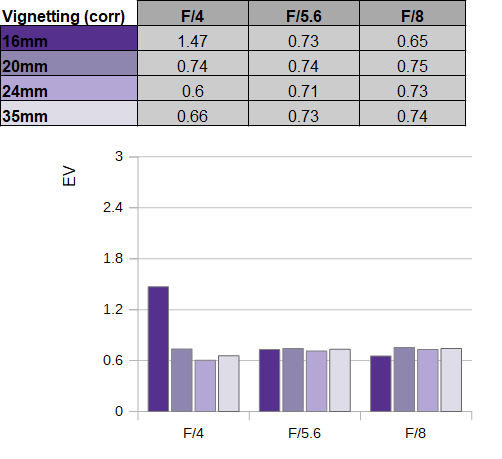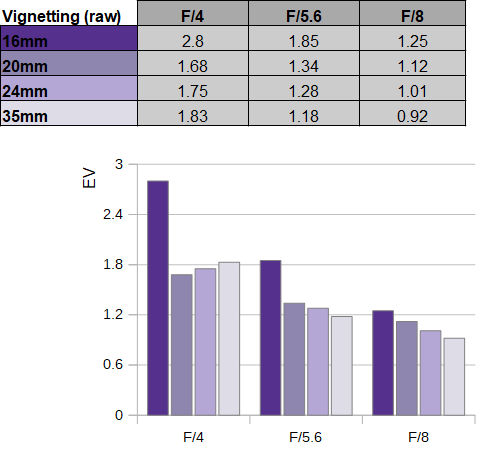|
Sony FE PZ 16-35mm f/4 G - Review / Test Report - Analysis |
|
Lens Reviews -
Sony Alpha (Full Format)
|
|
Page 2 of 3

Distortion
Image auto-correction is the de-facto standard today. Activated, you don't have to worry about distortions. They are near zero, as you can see below.
When looking at the RAW characteristic, we can see a very different "picture", though. At almost 9% barrel distortion at 16mm, the lens has almost fisheye-like qualities. More than 4% at 20mm is also very noticeable. Overall, it's pretty clear that this lens REQUIRES image auto-correction. That's not bad per se, but distortion correction is a lossy procedure.
Vignetting
In standard shooting mode (auto-correction activated) the vignetting is well controlled. There is a rather "normal" peak at 16mm f/4 with a light falloff of 1.5EV (f-stops). At other settings, it hovers around the 0.7EV mark, which is pretty acceptable for such a wide lens.
 The situation changes when looking at RAW images. The vignetting is very high at 16mm f/4 - at almost 3EV (f-stops), and the figures aren't all glorious at the other 16mm settings as well as at f/4 at longer focal lengths. That being said, they aren't any worse than on other comparable zoom lenses either.
The situation changes when looking at RAW images. The vignetting is very high at 16mm f/4 - at almost 3EV (f-stops), and the figures aren't all glorious at the other 16mm settings as well as at f/4 at longer focal lengths. That being said, they aren't any worse than on other comparable zoom lenses either.

MTF (resolution at 42 megapixel)
The most interesting aspect is, of course, image sharpness. The Sony FE PZ 16-35mm f/4 G surprises with a very homogeneous characteristic across the focal length range - which is unusual in this lens class. The broader center quality is superb at large to medium aperture settings. The outer image field is still good to very good. Diffraction has a higher impact from f/11 onward.
A word of caution from real-world use here. Do yourself a favor and don't rely blindly on the camera AF. We had some ultra-wide images where the camera focused "past infinity", rendering the foreground defocused. Thus remember your lessons about hyper-focal distances if you are into landscape images.
The field curvature is low. The centering quality of the tested sample was Ok.
Please note that the MTF results are not directly comparable across the different systems!
Below is a simplified summary of the formal findings. The chart shows line widths per picture height (LW/PH) which can be taken as a measure of sharpness.
If you want to know more about the MTF50 figures, you may check out the corresponding Imatest Explanations

Chromatic Aberrations (CAs)
Once again - on Sony cameras, you don't really have to worry about chromatic aberrations due to image auto-correction. However, even the RAW CAs are quite low, with an average CA pixel width of around 0.8px in the low to mid-range and less than that at 35mm.

Sun Stars
Below is s sequence of images from f/4 all the way up to f/16 - illustrating the Sunstar behavior (using LED lights). Sunstars are an aperture effect when shooting bright light sources such as street lights, the sun, etc. At f/4, thus at maximum aperture, the effect is very underdeveloped simply because the aperture is basically circular. The Sunstar effect increases the more you stop down - until a certain setting from where it diminishes again. If you scroll through the aperture range below, you may notice that the sweet spot is around the f/11 mark. The light rays are "pointy", which is considered to be more desirable than the "fan" variant.
|